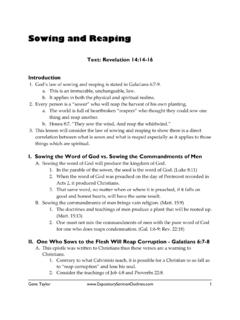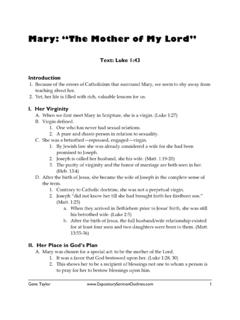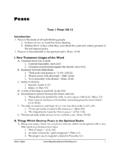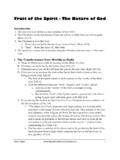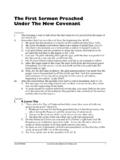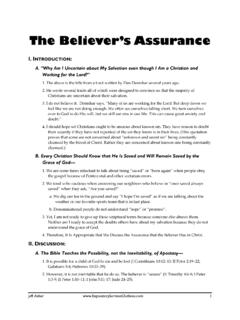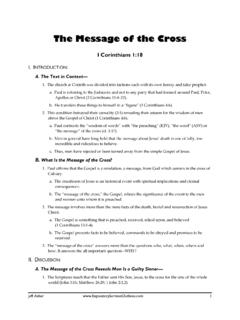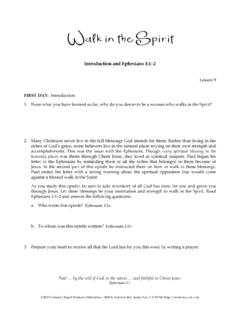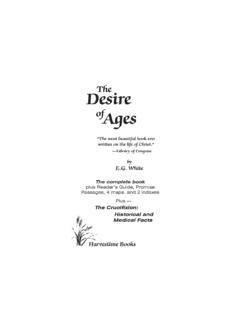Transcription of The Wonders of Calvary - Free Sermon Outlines
1 Jeff Asher 1 the wonders of calvary John 19:35 36 I. INTRODUCTION: A. The Wonders of Calvary 1. There are several things that occurred during the 24 hours of the Passover day on which Jesus was arrested and crucified that are little noticed or discussed. 2. Some of these are of a miraculous nature, while others are not strictly miracles as we would define them, but they are n onetheless events possessing a supernatural character. 3. These events have a definite and real significance as evidence establishing the true identity of Jesus of Nazareth and the importance of His death in Jerusalem nearly two millennia ago. B. The Text in Context 1. This statement is made in direct reference to the OT prophecies concerning Exodus 12:46 and Zechariah 12:10 15 that John later applies to the scenes he has just witnessed.
2 2. However, Jesus says Himself that everything that transpired with respect to His crucifixion and resurrection did so according to what the prophets had prophesied about Him (Luke 24:44 46). 3. Thus, it is certainly correct to say, These things were done that the Scripture should be fulfilled respecting all that occurred in connection with the death of Jesus. C. An Approximate Chronology for the Day Christ Died 1. 6:00 PM Passover begins in the upper room (Matthew 26:20). 2. 11:00 PM Jesus institutes the Lord s Supper (Luke 22:20; John 13:30). 3. 12:00 AM Jesus comes to Gethsemane to pray (Luke 23:38 40). 4. 2:00 AM He is arrested and taken before Annas (John 18:13). 5. 3:00 AM Jesus is brought before Caiaphas (John 18:24; Matthew 26:57). 6. 5:30 AM Jesus condemned by the Sanhedrin in the Temple (Matthew 27:1 2).
3 7. 6:00 AM Jesus is brought before Pilate the first time at Palace of Herod the Great (John 18:28). 8. 6:30 AM Jesus before Herod Antipas where He is examined and mocked (Luke 23:7 11). 9. 7:30 AM Jesus is returned to Pilate, accused, beaten and condemned (John 18:39 19:16). 10. 9:00 AM Jesus is crucified between two thieves at Golgotha (Luke 23:26 33; Mark 15:25). 11. Noon Darkness comes over the whole land (Mark 15:34) 12. 3:00 PM Jesus dies on the cross (Matthew 27: 50; John 19:30, 33 13. 3:00 PM Veil of the Temple is rent from the top downward (Mark 15:34 38). 14. 3:00 PM There is an earthquake so severe that the tombs are opened (Matthew 27:51 52). 15. 3:30 PM The legs of the two thieves broken in order to hasten death (J ohn 19:31 32). 16. 3:45 PM Jesus side pierced by a Roman soldier (John 19:33 36).)
4 17. 4:00 PM Joseph of Arimath a requests the release of Jesus body (Mark 15:43 45). 18. 4:30 PM The body of Jesus removed hastily to a nearby garden (John 19:41). 19. 5:30 PM The burial of Jesus before sundown on Friday (John 19:42). 20. 6:01 PM The Jewish leaders request a guard be placed on the tomb (Matthew 27:62).Jeff Asher 2 II. DISCUSSION: A. The First wonder : An Angel Appears from Heaven (Luke 22:43 45) 1. The Angels have always been curious about the redemption of mankind (1 Peter 1:12; Ephesians 3:10; I Timothy 3:16; Hebrews 12:22). a. They appear at significant events associated with man s falling away and return: (1) Angels were involved in significant events in the history of Israel: (a) They are stationed at the entrance to Eden to guard the Tree of Life (Genesis 3:24).
5 (b) They were God s instrument for delivering the Law to Moses (Acts 7:53). (c) They were at times the messengers of God in revelation to the prophets (Daniel 10:13; Jude 1:9; Zechariah 1:9 11). (2) Angels are intimately involved with Christ: (a) An angel announced the birth of Jesus (Matthew 1:20 21; Luke 1:28 38; 2:7 15). (b) An angel warned Joseph to escape to Egypt (Matthew 2:13) (c) Angels ministered to Jesus after the temptation (Matthew 4:11; Mark 1:13; John 1:51). (d) This angel ministered to Jesus in the Garden of Gethsemane (Luke 22:43). (e) Angels were present at the tomb of Jesus (Matthew 28:2 6). (f) They were present at the ascension (Acts 1:11). (g) They worship Christ in Heaven (I Peter 3:22; Revelation 5:11). (h) They will be with Christ at his second coming (Matthew 25:31; Mark 8:38; II Thessalonians 1:7; Jude 1:14 15).
6 (i) They will be with Christ at the judgment (Matthew 13:39, 41, 49; 16:27; 24:31; 25:31; Mark 13:27). b. They are said to minister on behalf of the saints (Hebrews 1:14). (1) I will not presume to say I know what they do (Deuteronomy 29:29; cf. Hebrews 13:2). (2) However, they are our angels (Matthew 18:10). (3) They are with us in the spiritual war (Daniel 10:12 13; 2 Kings 6:16 17; cf. 1 John 4:4). (4) I know that they minister for them who shall be heirs of salvation (Hebrews 1:14). (5) The angels rejoice when sinners are saved (Luke 15:7, 10). (6) They carry the spirits of the righteous into Abraham s bosom (Luke 16:22). c. Therefore, I am not surprised to find angels involved at this critical moment in the development of the scheme of redemption. 2. However, I am curious to know: Why now?
7 A. The course of the evening s events: (1) After observing the Passover with the Twelve Jesus retires to Gethsemane, an olive yard near the base of the western slope of the Mt. of Olives (Luke 22:39; John 18:1 2). (2) Jesus enters the garden and takes His three most intimate friends to a place of prayer (Matthew 26:36). (3) Three times Jesus prays: O my Father, if it be possible, let this cup pass from me: nevertheless not as I will, but as thou wilt (26:39). b. The observations of the Gospel authors: (1) And [He] began to be sorrowful and very heavy. Then saith He unto them, My soul is exceeding sorrowful, even unto (Matthew 26:37 38). (a) Sorrowful lupew [loo peh o]: according to Strong (3076) to distress; reflexively or passively, to be sad; according to Thayer: to make sorrowful; to affect with sadness, cause grief; to throw into sorrow.
8 (b) Very heavy adhmonew [ad ay mon eh o]: according to Strong (0085) to be sated to loathing; to be in distress (of mind); according to Thayer: to be troubled, Jeff Asher 3 distressed. (c) Exceeding sorrowful perilupov [per il oo pos]: according to Strong (4036) grieved all around, intensely sad; according to Thayer properly, encompassed with grief, very sad, exceedingly sorrowful. (2) And he taketh with him Peter and James and John, and began to be sore amazed, and to be very (Mark 14:33). (a) Sore amazed ekyambew [ek tham beh o]: according to Strong (1568) to astonish utterly; according to Thayer to be struck with terror. (b) Robertson observes in Word Pictures: Mark has the startling phrase greatly amazed and sore troubled (ekthambeisthai kai adeemonein), a feeling of terrified surprise.
9 (c) Vincent cross references other occurrences of the word unique to Mark (9:15; 16:5, 6). (3) And being in an agony he prayed more earnestly: and his sweat was as it were great drops of blood falling down to the ground (Luke 22:43). (a) Agony agwnia [ag o nee ah]: according to S trong (0074) a struggle (properly, the state), (figuratively) anguish; according to Thayer It is often used, from Demosthenes down, of severe mental struggles and emotions, agony, anguish. (b) His sweat was as it were great drops of blood falling down to the ground. [1] Of this phenomenon Robertson says, Thick, clotted blood. An old word (thromboi) common in medical works, but here only in the This passage (verses Lu 22:43 44) is absent from some ancient documents. Aristotle speaks of a bloody sweat as does Theophrastus.
10 [2] Alexander Metherell, MD, PhD notes: This is a known medical condition called hematidrosis. It s not very common, but it is associated with a high degree of psychological stress. What happens is that severe anxiety causes the release of chemicals that break down the capillaries in the sweat glands. As a result, there s a small amount of bleeding into these glands, and the sweat comes ou t tinged with blood (The Case for Easter, 15). c. It is at this moment that the angel comes from heaven to strengthen Jesus (Luke 22:43). (1) We should not be surprised to see this angel here with Jesus for all the aforementioned reasons (see under above). (2) We may be puzzled to see Him here because this is the Son of God, how could an angel possibly strengthen Him? (a) However, remember, this is the Son of God who humbled himself by stepping down from the glories of Heaven and was found in fashion as a man (Philippians 2:8) in all like unto His brethren (Hebrews 2:17) to be in all points tempted like as [they] are, yet without sin (Hebrews 4:15).
